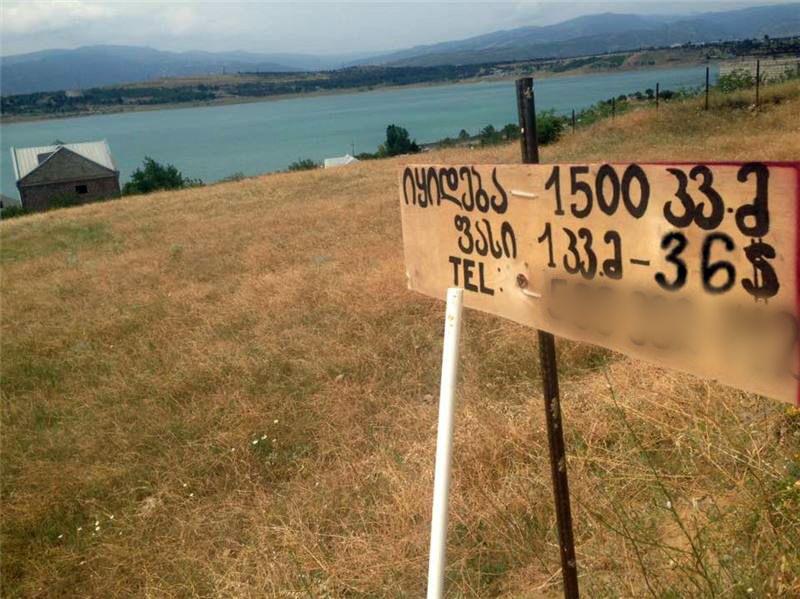Just like Duddy Kravitz, Georgian men (and women) appear to be reluctant to part with their parcels of land, however small and unproductive. Whatever the reason, Georgia sees almost no structural change out of agriculture, and, as a result, very low productivity and income growth for the poorest strata of its population. As of today, employment (or, rather, under-employment) in agriculture is a staggering 45% of Georgia’s total labor force.
As we have written on these pages, the notion that too many Georgians are ‘stuck in agriculture’ was a key element of the Saakashvili government’s modernization ideology. Accordingly, to catch up with the West, Georgia had to go through a process of land consolidation (creation of large private farms in place of tiny plots under 1ha which constitute the vast majority of Georgia’s agricultural holdings) and urbanization. Hence, the idea of building new cities such as Lazika (to provide the pull), and active neglect of agricultural policy (to push smallholders out of agriculture). When, finally, agricultural subsidies started being thrown at rural dwellers in 2010-2012, it was done for purely political reasons.
Georgian agriculture could certainly benefit from greater efficiency – both per worker and per ha. Yet, efficient agriculture of the kind that Georgia can potentially develop does not necessarily require “land consolidation”. Georgian smallholders cannot compete with the rest of the world in soya, maize and corn, in which scale is essential. They should not even try. That said, Georgia can have a competitive edge in niche agricultural products, such as branded alcohol, silk, honey, cheese, elite teas, or organic apple, citrus and nuts, in which production costs do not necessarily go down with scale.
Yet, to be successful, Georgian peasants have to become much, much better at farming. And they have to acquire a better organization – utilizing economies of scale in access to finance, agricultural inputs and services, joint processing and marketing. In fact, they have to become professional farmers.
GEORGIA NEEDS A DYNAMIC LAND MARKET!
Unfortunately for Georgia (and for themselves), the lion’s share of Georgian rural dwellers are far from being professionals. They are unable to help themselves or each other. Yet, they remain attached to their small pieces of land – whether because of its sentimental value or for lack of profitable urban employment opportunities.
Most observers agree that Georgian agriculture requires an urgent infusion of new blood – foreign-trained professionals and young Georgian enthusiasts like Baia Abuladze and her friends. On the one hand, what is needed is some degree of land consolidation and a gradual transition to industrial farming methods (as is already happening, for instance, in Kakheti). On the other, Georgia also has to create opportunities for modern family farming. And none of this can happen in the absence of an effective market mechanism to re-allocate land from those who are stuck in agriculture to those who see it as their vocation.
Hence, the million dollar question: what can be done to bring life to Georgia’s land market?
FOREIGN INVASION? A very original, Misha-esque solution to the problem was attempted by the Saakashvili administration in 2010-2012. The essence of it was to ratchet up land prices by opening the Georgian land market for competition by land-hungry foreigners (some of whom were even granted Georgian passports upon landing in Tbilisi). This solution assumed that Georgian farmers-by-default would sell their land, if only the price were right.
At first, this seemed like a good idea. South African Boers, as well as Egyptian, Panjabi and Iranian investors responded to Misha’s invitation. The government quickly repurposed and sold some of the state-owned pasture land to foreign farmers. Additional land could be acquired in the secondary market through Georgian intermediaries who jumped on the opportunity to offer their services.
Yet, this strategy backfired the moment foreigners began fencing and cultivating former pasture lands on which locals depended for their livelihoods. Instead of selling and leaving for the cities, Georgian villagers started invading fenced properties. What followed was a series of ugly incidents and clashes with the new land owners and police. By October 2012, Georgia had a new government. By June 2013, this tumultuous chapter in Georgia’s agricultural policy was closed by the infamous moratorium restricting foreigners’ access to agricultural land.
LAND REGISTRATION? One possible reason for the weakness of Georgia’s land market is incomplete land registration. Indeed, only a small portion of agricultural lands is properly registered in Georgia’s electronic cadaster. Closing this gap may be a good idea in its own right (to protect property rights). Yet, the Georgian Ministry of Justice (MoJ) has recently come up with a new – rather revolutionary – idea to require land owners to register their plots within a period of one year or face consequences in the form of de-jure nationalization.
Nobody doubts the Ministry’s intentions, but such an ambitious timetable is causing a lot of concerns. For one, the registration process envisaged by MoJ involves a costly surveying procedure which farmers may not be able to afford; even more importantly, by expediting the process beyond the government’s administrative capacity to handle disputes (e.g. over boundaries and faulty paper documents), MoJ is likely to jeopardize the very property rights it is purporting to protect.
But is there really any reason to believe that completing land registration would provide the Georgian land market with the impetus it needs so badly? It seems quite plausible that many peasants have not bothered to register their lands because they were not interested in selling. Why go through the bureaucratic hassle and pay costly fees unless you have a buyer in sight? If that’s the case, MoJ’s initiative will fail to deliver the economic bang for the buck. Subsistence farmers would continue sitting on their tiny plots, whether registered or not.
A TAX ON LAND? Surely, a tax on landed property, if high enough, could quickly force Georgia’s subsistence farmers off their tiny plots. However, even verbalizing such a strategy would be akin to committing a political hara-kiri in a democratic system in which rural voters have a major say. Moreover, what would Georgia do with hundreds of thousands of hungry and angry peasants??? The country’s private sector would not be able to provide enough jobs (all taxi driving jobs are already taken). And, in any case, keeping so many people on welfare is far worse than allowing them to maintain their traditional lifestyles, plots of land and dignity.
FINALLY, HOW ABOUT IMPROVING RURAL INFRASTRUCTURE?
There is a reason for Georgian subsistence farmers not to want to part with their plots. On the one hand, there is no cost to holding on to one’s land. Agricultural land is not taxed. Irrigation infrastructure, while in need of massive investment, is provided almost free of charge (water consumption is not metered; moreover, peasants often steal water from open canals; and even when they do contract the Georgian Amelioration company, the fees they pay for irrigation services are ridiculously low). Finally, the opportunity cost of holding agricultural land is also very low. Land prices are such that by selling one’s plot, no farmer would have enough money to move to a nearby city and start a new business.
At the same time, the opportunity cost of giving up on one’s plot of land is extraordinarily high for subsistence farmers. First and foremost, having a small piece of land provides reasonable insurance against hunger. Second, rural households very often find themselves on the receiving end of social welfare programs, agricultural subsidies (vouchers, price support, free insurance) and donor-financed support programs targeting Georgia’s agricultural sector. And, of course, there is the quality of rustic life and freedom that come with land ownership.
With no cost and so many benefits, no wonder Georgian subsistence farmers remain attached to their lands.
An impasse? Not necessarily, if the following two-pronged approach is pursued over time:
On the one hand, the value of agricultural land should increase. This could be achieved through continued public investment in rural infrastructure, including access roads, amelioration and irrigation services (which, alone, can greatly increase land productivity) and amenities (schooling, healthcare and culture).
On the other, peasants have to be gradually weaned off agricultural subsidies, raising the opportunity cost of staying in subsistence agriculture. Irrigation tariffs might be a good place start. Land served by modern irrigation infrastructure should be more expensive to hold whether farmers make use of this infrastructure or not.
The result will be market-driven self-selection into more professional, commercial family farming and urban migration. Farmers with a verve will use the opportunity to transition to higher productivity crops and/or cultivation methods. Farmers by default will sell their land plots (which will now have a higher commercial value) and move to other occupations and places.
The author is president with the International School of Economics at Tbilisi State University.
 The article was first published in Georgia Today - Georgia's leading English language newspaper, published twice weekly.
The article was first published in Georgia Today - Georgia's leading English language newspaper, published twice weekly.
















Comments
Land tax is property tax. The rate varies depending on the type of the land (arable, pasture etc.) and the location (municipality level).
According to Georgian Tax Code, article 204: https://matsne.gov.ge/ka/document/view/1043717
1) The rate on arable land varies from 56 to 100 GEL per hectare (depending on municipality).
2) The rate on pasture land varies from 5 to 20 GEL per hectare (depending on municipality).
Though, the are some exceptions, including:
1) The land registered by person until 1st of March, 2004, is exempted from land tax, if the size is less than 5 hectare. However, any transactions after that time (new title, new owner of the land, etc.) is a subject of taxation.
This latter fact happens to be one of the impediment factor why peasants do not officially transact their land (registering the real owners of the land in the public hall), because to avoid paying the land tax annually...
Farmers might have some other motivations for being reluctant to part with their parcels of land. Holding multiple small land plots provides some risk diversification. Also, in most cases only some part of family migrates to urban areas. This is also a way to reduce risk - if the family member who migrated is not very fortunate in the city at least some members maintain rural connections (and owning some piece of land goes with it). So, it is understandable that "farmers are attached to their small pieces".
I don't think that "Georgia sees almost no structural change out of agriculture". The preliminary results of Agricultural Census 2014 (http://www.geostat.ge/cms/site_images/_files/english/population/According%20to%20preliminary%20results%20of%20the%202014%20population%20census%20Final.pd) hint at some degree of structural transformation. Moreover, according to some recent surveys (e.g., ENPARD baseline http://www.iset-pi.ge/images/Projects_of_APRC/Agriculture_and_Rural_Development_in_Western_Georgia_A_Baseline_Assessment.pdf ) the most of Georgian farmers are old. So, we could be quite optimistic that some structural change will happen automatically. Of course this does not mean that we do not need good policies for accompanying and accelerating this process. This change, however, should be sustainable (considering not only economic but also social and environmental aspects). Part-time farming (very common in Europe) is a good candidate for ensuring sustainable structural change out of agriculture. Though, this "European model" in turn slowdowns the structural transformation...
This is interesting, and I agree with much of what you say. I agree with key things, such as improving infrastructure and reducing subsidies. (One big thing you leave out in potentially improving infrastructure is a concerted effort to re-create windshelters, since they are the key to productivity, and hard to grow privately for a number of reasons.)
That said, it really depends on the part of Georgia you look at. Land structure in eastern Georgia (consolidated villages) is very different from western Georgia (strung out villages along roads). So far, availability of land is not yet a constraint, unless you talk about giant investment (500+ ha) that arguably are problematic for other reasons. In the West we seem to be seeing a fair amount of selling and buying.
The other thing that should be mentioned with regards to productivity is (and I would say this) systematic outreach. Too much thinking is stuck in old-school approaches. I think Mosavali perfectly illustrates that newer approaches are possible, and can have a big impact.
https://twitter.com/HansGutbrod/status/702482430364688384